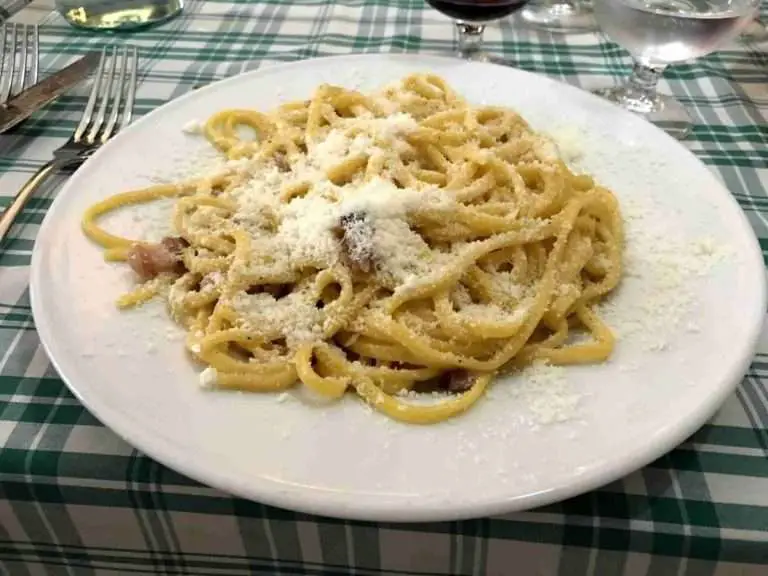
Dining is one of the best parts of the Italy travel experience. Of course, as you’ve probably read before, there are rules when it comes to enjoying a meal in Italy. I hate rules. But I do appreciate tradition, as well as learning about how Italians use and eat different ingredients.
So I was excited when Nan McElroy, author of the Living Venice Blog and the “Instructions for Use” travel series, approached me with a post about eating fish in Venice. I hope you enjoy this post as much as I did and I also hope that her tips come in handy when you’re in Venice for your next dining adventure.
Nosh Venice Fish, But Leave That Lemon Alone: Advice from a Fresh Fish Fanatic
You’re town for a few days, for the Biennale, for the Film Festival, for the Regata Storica; before-cruise, after-cruise, or for the month. And tonight, you’ve chosen the restaurant where you’ll treat yourself to Venice’s precious pesce.
If you’ve done your homework and chosen your eatery carefully, you’ll rarely be disappointed. Even non-fish fans, if they can be tempted, become converts, as often this freshest of fish bears no resemblance to the more common frozen fare — something that, should a restaurant even consider serving to a local, will at best cause them never to return; at worst, incite a heated argument that can end with the guest either storming out or being asked to leave. Harrumph.
Venice has always treasured (if not totally depended upon) its fish, whether from the lagoon or the upper Adriatic, and never tires of finding new ways to consume it and serve it to their guests. You’ll select from baked, grilled, sauteed, raw and even whipped versions of familiar (or less so) species; flat, fat, large and small; shellfish and mollusks, with and without shells, without and without backbones. Traditionalists will opt for the fabulous frittura, often rating various locales’ versions on crispness, abundance, and the fish-to-vegetable ratio — each important when defending your choice for the best fritto misto fried fish platter in town.
And the lemon wedge? A common fish-dish accompaniment anywhere else in the world, but to a Venetian fish purist an appalling idea. Figurati should a slice wend its way to the plate.
Come mai, why is that? Because (explained the self-proclaimed fresh fish purist), the fish served at your dining table is a treasured thing. It’s just arrived from the sea (or better have), “swimming with its brothers” as they say, only hours ago. It’s expensive (we had to wait years for that branzino to get to a catchable age — not six- or 12-months for a force-fed farm-raised antibiotic-ingesting mutant). And it’s a delicacy, whether a tiny schie lagoon shrimp, a robust rombo turbot, or a magnificent blue or yellowfin wrestled from the Japanese sushi trade.

And you want to put lemon on it? Macché! Don’t even think about it.
It’s true — where lemons are concerned, what’s obvious to maniacal fresh-fish devotees may not be so obvious to everyone else. If you ask a few of them, they’ll tell you there are actually some fairly logical reasons to let the lemon lie.
First, the fresh fish you find served in Venice have marvelous, sometimes delicate flavors (mostly non-fishy, by the way); the chef has prepared today’s catch to enhance them. If you smother them with lemon juice, what will you taste? In their eyes, the lemon homogenizes these very distinctive fish dishes — and nobody wants that. In fact, lemon is more for fish that’s, well, been around, that has defects to overcome — not for fresh fish flesh. Finally, expert fryers will work tirelessly to serve you the crispiest frittura possible. So what happens when you squeeeeeeze a half of lemon over the mound of crunchy fried fish?
Lemon mush, that’s what. Una tragedia, a real heart-breaker.
In a labor-saving move, or perhaps because they lack the fish-faithful culture of a born-and-raised Venetian, many restaurants have just given in and included the lemon as garnish. There are other eateries though, who will flat refuse to serve you the lemon (along with any sort of grated cheese, by the way), so best be prepared.
Why not compromise? Before you request a lemon wedge, or crush the one on your plate over its contents out of habit, why not simply sample what’s been served to you as is? If you’re eating in a restaurant famous for its fish, you’ll be surprised at how unnecessary the lemon might seem (try a light olive oil drizzle if you must). And — you’ll be immediately categorized as an informed fish fan. (When in Venice, and all that…)
So, will you become Venice’s next fish purist? Who’s to say? In any case, the fresh fish found here is certainly worth indulging in. Enjoy!
Last updated on December 15th, 2020Post first published on September 14, 2010






